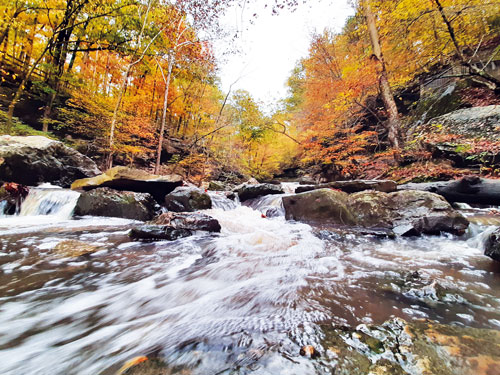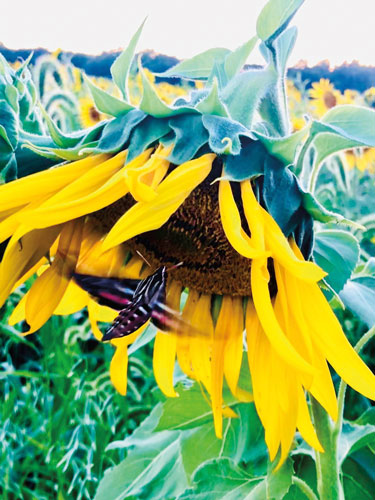About Outdoor Indiana
Outdoor Indiana, the state's premier magazine, delivers the wonders of the Hoosier outdoors to subscribers' homes and offices six times a year in 48 pages of vibrant color. For the best of state parks, lakes, wildlife, forests, trails, hunting, fishing, wildflowers and outdoorsy people, plus inside information from DNR experts, subscribe for $15 per year or $28 for two years. Follow the magazine staff on Facebook.
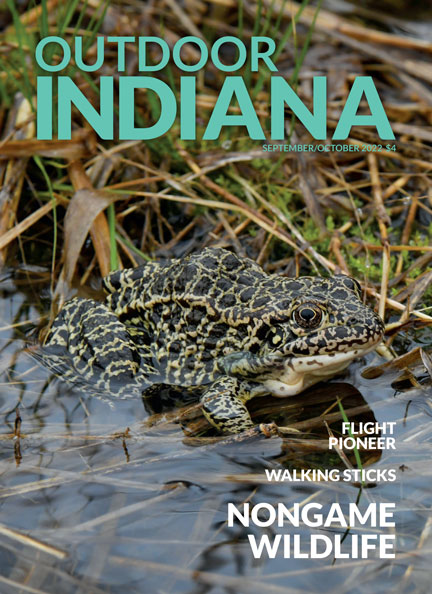
A male crawfish frog, aka Hoosier frog, enjoys a Hillenbrand Fish & Wildlife Area pond.
Featured Stories
- From the director
DEER HUNTERS FEED THE NEEDY

DNR Director Dan Bortner
Deer hunting season is once again upon us. Reduction zone and youth hunting begins in September, and archery season starts in October. Hunting stimulates the economy, supports conservation efforts, and is a great way for Hoosiers to make memories with friends and family members.
It is also a great way to help neighbors in need.
Last year the Indiana DNR, through the Division of Law Enforcement’s Sportsmen’s Benevolence Fund, awarded Hoosiers Feeding the Hungry a $75,000 grant for its “Meat” the Need program. These funds help Hoosiers Feeding the Hungry pay processing fees for donated deer and venison.
The way the program works is simple. After a successful harvest, hunters can donate their field-dressed deer at a local participating processor. The Sportsmen’s Benevolence Fund pays the processing fees for whole-deer contributions, and the processor creates healthy venison burgers to distribute to food banks. In the last six years, this program has provided nearly 3.5 million meals to Hoosiers in need.
Hunters who are not interested in donating a whole deer but would still like to make a difference can choose to “Give a Pound” by processing their deer at their own expense and letting the processor know how much processed meat they wish to donate.
The Dubois County Sportsmens Club and Hunters and Farmers Feeding the Hungry run similar programs.
Learn more at on.IN.gov/dnrlaw-sbf or by asking a processor.Spread the word, happy hunting, and thank you, deer hunters, for helping Hoosiers.
- MANY HAPPY RETURNS
Here’s to another 40 years of the Nongame Wildlife Fund
By Marty Benson, OI staff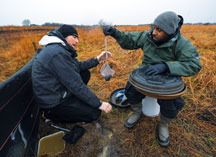
MDNR Fish & Wildlife’s Jason Mirtl (left) and David Wiles (right) weigh a state endangered crawfish frog, sometimes called a Hoosier frog, as part of a mark-recapture study in Greene County.
Celebrating a 40th birthday can mean denial, the honoree claiming to be 39—or maybe 29, if they can pull it off.
Not so with the Indiana Nongame Wildlife Fund, which came to be in 1982. It’s thrilled to commemorate the big four-oh. No black balloons allowed, not even in jest. Forty years means it’s time to party and recognize the accomplishments made and that will be made possible by donors, partners, and volunteers.
The fund is exactly what it sounds like. It is the financial source of support for the conservation of nongame and endangered species in the Hoosier state. “Nongame wildlife” means any wild mammal, bird, reptile, amphibian, fish, mollusk, or crustacean that is not hunted or trapped for sport or commercial use. That is the vast majority of the animal species most Hoosiers are familiar with. The fund is needed because the effort is supported entirely by voluntary contributions and the federal dollars they trigger, which can turn every $5 donated into $14 for nongame support in Indiana.But back to the festivities. To have a good party, you need a FUN(d) cast of characters. We’re in luck on that front because these species are a diverse, quirky bunch—party animals, dare we say?
- ‘HAND ME DOWN MY WALKING CANE’
Useful tool, trail companion, keepsake and more
By Scott Roberts, OI staff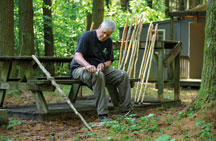
Mark Lods strips the bark off what will eventually become a walking stick.
A warped hiking stick that’s more in the shape of the letter “C” than straight sits in a corner of Randy Johnson’s garage.
The Connersville resident still occasionally uses it on walks, even though the stick’s nuances make doing so awkward. He mostly uses trekking poles when hiking now, but this stick holds too many memories from 47 years of hitting the trail to part with it.
Johnson remembers whittling it from an ash sapling, taking care to smooth it, getting the grip where he wanted, and making it the perfect height. It was with him years ago as he hiked from Springer Mountain in Georgia all the way to Vermont.
“It’s kept my nose out of the dirt and assisted me on the climbs,” Johnson said. “It’s been a faithful companion to me on many adventures, and it’s great to remember them.”
Many hikers have similar stories, how their stick became more than a tool, markers for their life.
- Octave Chanute set the stage for powered flight at Indiana Dunes
GLIDING TO SUCCESS
By Scott Roberts, OI staff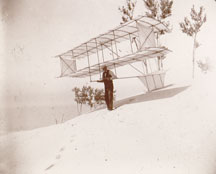
Chanute holds his biplane glider with side panels in August 1896 (Chanute photo album, Manuscript Division, Library of Congress).
On a sandy, windswept shore, three men stomp across the hilly dune country, heavy bags in tow. Their load includes hammers and saws, spruce wood, Japanese silk, and a host of other materials to help them try to achieve their goal of flying.
While that may sound like an introduction to the Wright brothers’ famous aerial doings at Kitty Hawk, the scene took place in 1896, seven years before the siblings from Ohio successfully took to the skies, and many miles from their takeoff site in North Carolina’s Outer Banks.
The men—Octave Chanute, William Avery, and Augustus Herring—were trudging over the Indiana Dunes near the Miller Beach neighborhood in northwest Indiana. Chanute’s then-groundbreaking book, “Progress in Flying Machines”, later convinced the Wrights and many other experimenters flight was possible. Its pages also provided a practical blueprint for those aviation pioneers to use in their attempts.
Chanute’s successful glider experiments at the Dunes pushed powered flight closer to reality. The ideas he established during tests of multiple glider designs regarding lift and stability were the basis for the Wrights’ glider and first airplane. Chanute also mentored and encouraged the brothers, and he exchanged hundreds of letters with them. He also visited the Wrights at Kitty Hawk several times to provide in-person advice.
The Chanute Aquatorium, located close to where his first glider experiments took place, commemorates Indiana’s flight pioneer. Constructed as a bathhouse in 1921, thus its name, it’s now a mini-museum of flight. In 1994, it was listed on the National Register of Historic Places, the Indiana nominations to which are managed by the DNR. On one of side of the building is a statue of Chanute, with his distinctive facial hair, and a model of his most successful glider. The other side is dedicated to the Tuskegee Airmen, a mostly African American flight squadron that became famous for its heroics during World War II.
A replica of the glider also hangs from the ceiling of the visitor center at Indiana Dunes National Park, which features a display detailing the local flight pioneer’s achievements. Every August, the national park hosts an Aviation Day featuring programs on Chanute and early flight, and shows a documentary titled “Patron Saint of Flight”. In addition, Simine Short, author of “Locomotive to Aeromotive, Octave Chanute and the Transportation Revolution”, gives a talk.
But despite these commemorations, few people are familiar with Chanute, even though some call him The Father of Aviation.
Reader Photos
Each issue, Outdoor Indiana staff will select reader submitted photos to feature in the magazine. If you would like the chance to be featured, please submit your photo, along with your name and phone number to:
Please, only submit original photography that you have taken. Do not send files over 9 MB in size. JPG format is preferred.
Subscribe to Outdoor Indiana magazine
Visit the Indiana State Parks online store to subscribe. Cost is $15 for a one year subscription (6 issues) or $28 for two years (12 issues).
Donate
Printing and distribution costs for Outdoor Indiana magazine have increased. One way we’re offsetting these costs is through the Friends of Outdoor Indiana Group administered through the Indiana Natural Resources Foundation. Donations to our friends group helps keep our subscription price low and ensures we’ll be around to bring you the best of Indiana’s outdoors for years to come. Donate at the INRF website and include “Friends of Outdoor Indiana” in the “In Honor Of/In Memory Of” line.
Outdoor Indiana
402 W. Washington St., W255-B
Indianapolis, IN 46204
317-233-3046
OIorders@dnr.IN.gov

